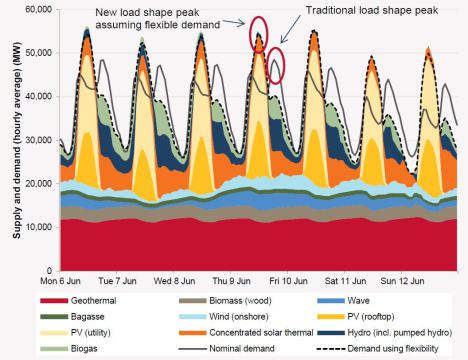Guest post by Dr Ted Trainer, University of NSW (http://ssis.arts.unsw.edu.au/tsw/).
For other critiques of the “100 Per Cent Renewables Study – Draft Modelling Outcomes” report on BNC, see here and here.
Summary: The AEMO report concludes that 100% of Australian electricity demand could be met by renewable energy sources. The claim is far from established and highly challengeable because some of the assumptions etc. are implausible and not likely to be borne out, and some crucial factors haven’t been taken into account. Intermittency has not been dealt with at all satisfactorily, embodied energy costs seem not to have been considered, and it is admitted that some major costs have not been included. It is clear that a thorough study would have arrived at an annual capital cost in the early years of construction that was several times the sum claimed. The main issue with renewables is not whether it is technically possible for them to meet total demand – it is whether the large amount of redundant plant needed to deal with intermittency could be afforded.
This study concludes that 100% of Australian electricity demand could be met by renewable energy sources. I think it is a valuable study, providing useful information, the kind of exploration we need, and in general its pronouncements are acceptable — if the assumptions and inclusions/exclusions that are made clear are accepted. However the 100% claim is far from established and highly challengeable because several of the assumptions etc. are implausible and not likely to be borne out, and some crucial factors haven’t been taken into account. Intermittency has not be dealt with at all satisfactorily, embodied energy costs seem not to have been considered, and it is admitted that some major cost factors have not been included. It is clear that a thorough study would have arrived at an annual capital cost in the early years of construction that was several times the sum claimed.. Following is a brief indication of some problems.
The amount of redundant, back-up plant required.
The core issue with high penetration renewables claims is to do with the amount of plant that would be needed to deal with the intermittency of wind and sun. When both are low supply can be maintained only if there is a substantial amount of some other kind of generating capacity, or of storage capacity, that can be turned to. Proposals attempting to provide for this end up having to assume very large quantities of back-up plant. For instance in the Elliston, Diesendorf and MacGill proposal (2012) the multiple is 3.37. In the Hart and Jacobson proposal for California (2011) the multiple is 4.3. They found that in order to meet a 66 GW demand with low carbon emissions no less than 281 GW of capacity would be needed. This would include 75 GW of gas generating capacity which would function a mere 2.6% of the time (p. 2283) and it would provide only 5% of annual demand. This means 75 power stations would sit idle almost all the time.
Filed under: Renewables, Scenarios | 2 Comments »






.png)






